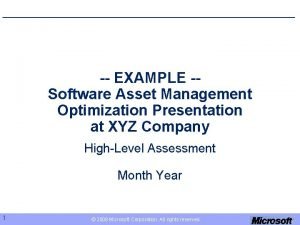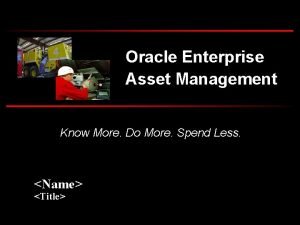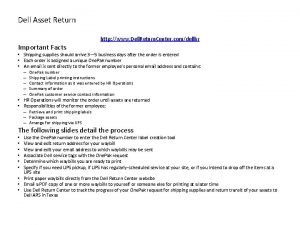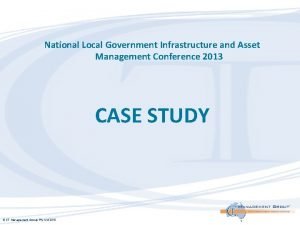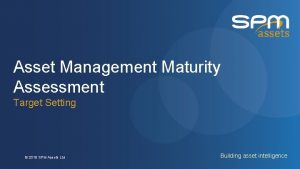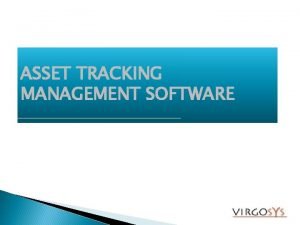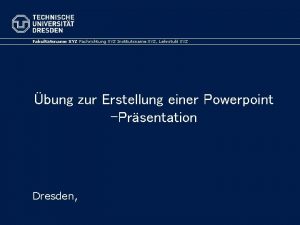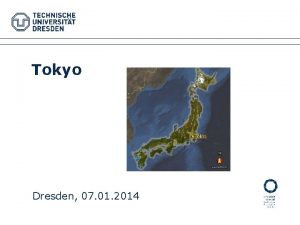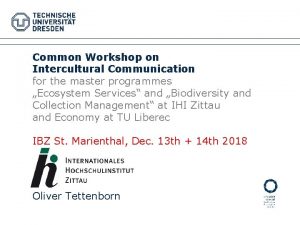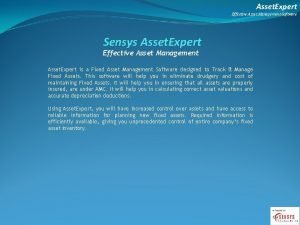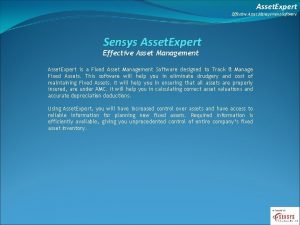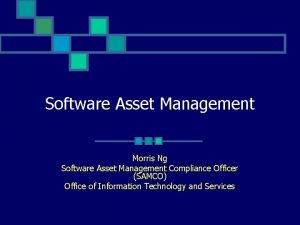EXAMPLE Software Asset Management Optimization Presentation at XYZ










- Slides: 10

-- EXAMPLE -Software Asset Management Optimization Presentation at XYZ Company High-Level Assessment Month Year 1 © 2008 Microsoft Corporation. All rights reserved.

Table of Contents 1 Executive Summary 1. 1 Background 1. 2 Infrastructure Optimization 1. 3 Approach 2 Company Infrastructure Optimization and SAM Review 2. 1 Present State Analysis 2. 2 Future State Analysis 3 Company Action Plan 3. 1 Action Plan and Recommendations 3. 2 Road Map 4 Appendix: SAM Optimization Model 3 9 13 16 Appendix: Business Case (Optional SAM Partner content) 17 2 © 2008 Microsoft Corporation. All rights reserved.

Executive Summary • Background • Infrastructure Optimization • Approach 3 © 2008 Microsoft Corporation. All rights reserved.

Company Infrastructure Optimization and SAM Review • Present State Analysis • Future State Analysis 4 © 2008 Microsoft Corporation. All rights reserved.

Present State Analysis SAM Component Assessment for Company Microsoft's Partner has considered the components of SAM and has ranked their maturity across the four levels. Results indicate that a majority of Company’s SAM components are of the standardized level. The following slides present a breakdown of our findings across People, Process, and Technology. SAM throughout Organization Periodic Evaluation Acquisition Process Hardware & Software Inventory Retirement Process SAM Operations/ Mgmt Interfaces Accuracy of Inventory Deployment Process Basic Standardized Rationalized Dynamic SAM Improvement Plan 5 License Entitlement Records © 2008 Microsoft Corporation. All rights reserved.

Future State Analysis Basic SAM Throughout Organization Standardized Project Manager assigned but SAM roles and responsibilities not defined. Direct SAM responsibility is identified throughout organization. Future State Rationalized Each functional group actively manages SAM. Dynamic SAM responsibilities defined in job descriptions across organization. SAM Improvement Plan No SAM development or communication plan. SAM plan is defined and approved. SAM Improvement is demonstrated. SAM goals part of executive scorecard; reviewed regularly. Hardware and Software Inventory No centralized inventory or < 68% assets in central inventory. > 68% - 95% of Hardware and Software in Inventory. > 95% -98% of Hardware and Software in Inventory. 99%+ - Asset inventories reconciled dynamically. Dynamic discovery tools provide near real-time deployment details. Accuracy of Inventory Manual inventory; no discover tools. Inventory sources reconciled annually. Inventory sources reconciled quarterly. License Entitlement Records Procurement manages contracts; not accessed by IT managers. Complete entitlement records exist across organization. Entitlement records reconciled with vendor records. IT operations managed on ad-hoc basis. Annual sign-off on SAM reports. Quarterly sign-off on SAM reports. Periodic Evaluations SAM Operations Mgmt and Interfaces 6 Current State SAM not considered part of M&A risk plan and company integration. SAM entitlement system interfaces with vendor entitlement to track usage. System reconciliations and ITAM report available on demand. Operations manages separate asset inventories. Operations manages federated asset inventory. All business units, etc. follow the same strategy, process, and technology for SAM. Software purchases based on deployment/entitlement reconciliation. All purchases are made using a pre-defined asset catalogue; based on metered usage. Acquisition Processes Assets purchased on a per project basis; without a review of current availability. Software purchases use approved vendors. Deployment Processes Assets deployed by endusers in distributed locations; no centralized IT. Only approved software is deployed. Retirement Processes No organized retirement process. Software retirement is tracked. Software deployment reports are accessible to stakeholders. Software is dynamically available to users on demand. Retired software is reused. Upon retirement, a comprehensive process is automated. © 2008 Microsoft Corporation. All rights reserved.

Company Action Plan • Action Plan and Recommendations • Road Map 7 © 2008 Microsoft Corporation. All rights reserved.

APPENDIX 8 © 2008 Microsoft Corporation. All rights reserved.

SAM Optimization Model Basic SAM Ad Hoc Little control over what IT assets are being used and where Lacks policies, procedures, resources, and tools. Standardized SAM Rationalized SAM Dynamic SAM Tracking Assets Active Management Optimized Vision, policies, procedures, and tools are used to manage IT S/W asset lifecycle. Reliable information used to manage the assets to business targets. Near real-time alignment with changing business needs. SAM processes exist as well as tool/data repository. Information may not be complete and accurate and typically not used for decision making. © 2008 Microsoft Corporation. All rights reserved. 9 © 2008 Microsoft Corporation. All rights reserved. SAM is a strategic asset to overall business objectives

SAM Optimization Model Competencies ISO 19770 -1 Organizational Management SAM Core Inventory SAM Core Verification SAM Core Operations management and interfaces Lifecycle Process Interfaces Key Competency Question SAM throughout Organization How has software asset management (with documented procedures, roles, responsibilities and executive sponsorship) been implemented in each infrastructure group? SAM Self Improvement Plan Does your organization have an approved SAM self improvement plan? Hardware and Software Inventory What percentage of user PCs and servers are included in a centralized software inventory/CMDB (configuration management database); which is populated by a software tracking tool? Accuracy of Inventory How often do you reconcile software inventories with other sources to verify accuracy of assumed license metrics (for example user counts based on HR employee records. )? License Entitlement Records What percentage of procured software licenses are recorded in a license entitlement inventory (a central repository/tracking of all licenses owned and/or previously acquired)? Periodic Self Evaluation How often do you reconcile software deployments (usage) to software entitlements (purchases)? Software entitlements are software licenses owned or previously acquired. Operations Management records interfaces How do the various Operations Management functions (contracts, financial fixed assets, service support, security, networking) use software and hardware inventories in their daily roles? Acquisition Process What percentage of total software purchases in your organization are made through or are controlled and tracked by centralized procurement? Deployment Process What percentage of total software deployed across organization's PCs and servers (considering all operating systems) is installed through centralized sources or through a controlled distribution environment? Retirement Process What percentage of retired hardware assets are tracked in a way to enable the software on them to be reused? * Additional SOM scorecard details are available to assist with objective testing. 10 © 2008 Microsoft Corporation. All rights reserved.
 Software asset management sam core
Software asset management sam core Roof asset management software
Roof asset management software Enterprise asset management oracle
Enterprise asset management oracle Dell return label
Dell return label Software asset management microsoft
Software asset management microsoft Software asset management ibm
Software asset management ibm Software asset management conference
Software asset management conference Software asset management maturity model
Software asset management maturity model Asset management vs project management
Asset management vs project management Right-of-use asset balance sheet presentation
Right-of-use asset balance sheet presentation Asset verification software
Asset verification software
